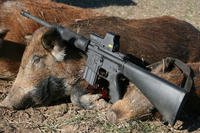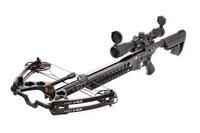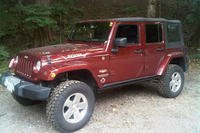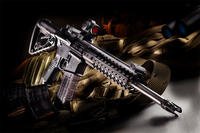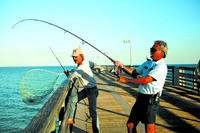Many hunters automatically choose an AR with a plain barrel without first considering how a flash hider or a muzzle brake/compensator can help in a hunting scenario.
By Steve Felgenhauer
Do flash hiders and/ or compensators have a place on an AR hunter’s rifle?
Many hunters automatically choose an AR with a plain barrel without first considering how a flash hider or a muzzle brake/compensator can help in a hunting scenario. This comprehensive look at flash hiders and compensators, their function and application, will clear up questions as to whether AR hunters need one or the other, or a combination of both.
Flash Hiders
There is much confusion about flash hiders, a very popular component on many ARs today. A flash hider for tactical shooters (law enforcement and military) is indispensible - it helps minimize the telltale muzzle flash that can give away their position. A well-designed flash hider can reduce the "bloom" caused by the muzzle blast while viewing through night vision goggles. The reduced flash also helps keep a shooter's night vision, the ability to see in low-light conditions, from being disabled. Bear and hog hunters or those who call and hunt predators in low light or at night will find the benefits of a flash hider equally indispensable.
Early rifle designs had longer barrels than today's modern rifles. One of the advantages of long barrels is that all of the powder is completely burned within the confines of the barrel, producing little to no flash. After World War II, troops saw the advantages of a short barrel on their issued rifles, especially in jungle combat environments. The trade-off was muzzle flash that increases as the barrel is shortened. Powder not burned inside the confines of the barrel creates the flash at the muzzle as the bullet exits. Rule of thumb: The shorter the barrel, the larger the fireball.
Flash hiders, originally referred to as flash suppressors, were designed to break up and vent the flash in a sideward direction away from the barrel. Flash hiders have been on AR's since the 1950s. The Colt Sporter I, the first commercial AR, had a cone-shaped improved duckbill type flash hider, named for its appearance; however, its exposed opening had a tendency to get hung up on brush. The next improvement was the birdcage flash hider with a solid bottom to prevent a dust storm when firing from a prone position. Manufactures have made great strides with new and sometimes radical designs in flash hiders - some proved to be effective, others not so much. Still, flash hiders are important for those hunting in low-light situations.
Compensators, Recoil Reducers, and Muzzle Brakes
A bolt-action rifle equipped with a muzzle brake barely causes a second look at a gun show. However, if the rifle is an AR, it quickly becomes the centerpiece of all conversations. Not many years ago, an AR equipped with a flash hider/compensator or even threaded end was deemed illegal if it was coupled with other physical characteristics such as a folding or telescoping stock, a bayonet lug, or a pistol grip. Luckily, the dreaded Assault Weapons Ban expired.
The terms compensators, recoil reducers, and muzzle brakes are interchangeable. For the most part flash hiders and compensators/muzzle brakes are threaded to the muzzle, although several manufacturers produce both clamped-on and pinned-on models. Compensators alter the path of the gases exiting the barrel, much like flash hiders. But, this is where the similarity stops.
Newton's third law of motion explains the theory behind recoil reducing devices. For every action there is an equal and opposite reaction. Simply stated, recoil-reducing devices reduce perceived or felt recoil by diverting a portion of the burning gases behind the projectile to the side rather than adding additional rearward recoil, therefore reducing the rearward thrust. The effect can be compared to reverse-thrust systems on aircraft jet engines.
There are countless models of recoil-reducing devices. Some are simple tubes with ports milled or drilled at 90 degrees, other models use elaborate expansion chambers to redirect the gases thereby reducing recoil. By reducing recoil and changing gas direction, they also help to reduce muzzle lift.
Are recoil reducers necessary? For the casual plinker the answer is no. However, as new higher-pressure cartridges are added to the AR platform, they are becoming more common. Anyone who spends much time behind the stock shooting a thumper like the .300 Remington Short Action Ultra Magnum, a .450 Bushmaster, .458 SOCOM or .50 Beowulf will soon appreciate a recoil-reducing device. Prairie dog, varmint shooting, and predator hunters welcome an ultra fast follow up shot without losing the sight picture or target in the scope.
Many shooters think that only large-caliber rifles need a recoil-reducing device, however, all rifles can benefit from one since they help eliminate muzzle rise - noticeable when shooting in rapid succession whether standing, sitting, or prone.
Installing flash hiders / compensators
Though some flash hiders/compensators can be simply screwed into place, many are indexable - meaning they must be oriented in a specific direction or position to work properly. The holes or slots in a brake are designed to vent the gases away from the shooter while redirecting them in a way to reduce perceived-felt recoil. If the device is improperly installed, the recoil and blast could come back in the shooter's face and the rifle could recoil downward or in an unwanted direction making it no better and perhaps worse than before the device was installed. Though the barrel is threaded to accept these devices, it is nearly impossible to always screw it to be in this exact position. Therefore, the use of a crush, peel, or lock washer is needed to properly align the device. A crush washer is a conical washer that flexes when the device is tightened against it to index the device in the appropriate position. A peel washer is made of thin washers that are lacquered together. The user peels away unwanted layers of the washer, altering its thickness and subsequently the seating of the device, again to make the device index in the desired position.
Are slots milled in the recoil reducer more effective than drilled holes? There is little proof that one design is better at reducing recoil better than others. The ones deemed the most effective all have similar qualities designed in them: An expansion chamber, holes milled or drilled perpendicular to the bore, and made of high-quality material.
The Down Side
There are tradeoffs to using muzzle brakes. Redirected gases also make the report of the rifle appear much louder than a rifle not equipped with a muzzle brake, especially if the ports are directed toward the shooter. For this reason, shooters in close proximity of a rifle equipped with a muzzle brake should wear proper eye and hearing protection. Safety note: Many experienced shooters double their hearing protection by using ear plugs inside of conventional ear muffs when a muzzle brake is in use. The rifle equipped with a muzzle brake also has more felt concussion near the muzzle than one not equipped with one. This muzzle blast can also be dangerous. Since the gas is directed in a more focused path and through restricted ports, it's capable of burning or cutting objects - vehicle roofs or hoods, as well as clothing. When using a rifle with any muzzle brake, keep the end of the muzzle clear from everything.
If you order either a flash hider or compensator for a rifle you already own, be sure to order the correct part for the proper caliber. Though the part might fit the barrel, the exit hole in the muzzle brake might be too large for the device to be effective, or too small, damaging the device, the rifle, and the shooter.
Accuracy is not normally affected by the installation of a flash hider or muzzle brake, however anomalies do occur. If accuracy suffers after installing a device, a plethora of reasons can be responsible: Over-tightening, an undersized bore, oversized bore, the threaded hole being unconcentric with the bore or the barrel being machined unconcentric with the bore are just a few that come to mind.
Suppressors-----Taking It A Step Further
Sound suppressors are legal to own in more than 35 states. Many have no restrictions on using suppressed rifles to hunt non-game animals such as coyote and feral hogs. There are several steps to conform to the legality of possessing a sound suppressor both state and federal, including a special stamp or tax that travels with the device issued by the Bureau of Alcohol Tobacco and Firearms. Currently, the stamp costs $200. Generally, you contact a Class III Dealer who sells suppressors and he will (usually for a fee) walk you though the paperwork required to get your suppressor. For a Class III dealer in your state, check www.subguns.com for their recommended dealers list.
Suppressors For Hunting?
One situation that is perfect for sound suppressors is predator/varmint control in urban and suburban areas. The urban varmint hunter works at hours when others close by are sleeping or watching a late movie. Mainstream media and the non-hunting public equate loud noise from a firearm to danger. Also, a suppressor will frequently allow acquisition of multiple targets without them spooking. A properly constructed sound suppressor will reduce the sound so it is no longer recognizable as a gunshot, clearing the way to get the job at hand done.
One of the biggest complaints with using a suppressor is the need to re-zero each time the suppressor is installed, however, new technology has taken the method the suppressor is attached to the barrel to new extremes that also ensure accuracy repeatability.
Whether you are looking to control muzzle rise, or heavy recoil with a muzzle brake or blinding muzzle blast with a flash hider, there is an easily installed fix for your AR.
